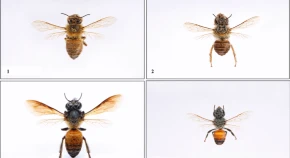Morphometric characterization of Apis species (Hymenoptera: Apoidea)
Research Articles | Published: 02 July, 2020
First Page: 538
Last Page: 544
Views: 3795
Keywords: Apis , Honey bees, Image acquisition programme, Morphological characterization, Pollination
Abstract
Honey bees assume a highly significant role in the sustainable agricultural productivity accomplished through effective pollination and successful plant reproduction. The investigations on the morphological traits of honey bees are highly important for their role in discrimination and conservation of different subspecies/races/ecotypes for accounting biodiversity. The studies on the bee diversity, pollination ecology and conservation of bee pollinators are hindered worldwide due to difficult taxonomy of bees, lack of bee taxonomists and the relevant literature. We employed morphological characterization on four honey bee species based on 39 characters using the image acquisition programmed zoom-stereo microscope. The results are useful to study the races/ ecotypes in different parts of country and for developing computer based automated system of their identification.

References
- Abou-Shaara HF, Draz KA, Al-Aw M and Eid K (2011) Simple method in measuring honey bee morphological characters. In: Proceedings of the 42nd international apiculture cong-Apimondia, pp 222, Buenos Aires
- Ananda MR (2000) Studies on morphological characters and behavoural traits of Indian honeybee, Apis cerana indica F. from different parts of Karnataka. M.Sc. Thesis, UAS, Bangalore
- Bouga M, Alaux C, Bienkowska M, Büchler R, Carreck NL, Cauia E, Chlebo R, Wilde J (2011) A review of methods for discrimination of honey bee populations as applied to European beekeeping. J Apicult Res 50(1):51–84
- Buco SM, Rinderer TE, Sylvester HA (1987) Morphometric differences between south american africanized and south african (Apis mellifera scutellata) honey bees. Apidologie 18:217–222
- Engels W (1999) The taxonomy of recent and fossil honey bees (Hymenoptera: Apidae: Apis). J Hymenopt Res 8(2):165–196
- Gallai N, Salles JM, Settele J, Vaissière BE (2009) Economic valuation of the vulnerability of world agriculture confronted with pollinator decline. Ecol Econ 68:810–821
- Klein AM, Vaissière BE, Cane JH, Steffan-Dewenter I, Cunningham SA, Kremen C, Tscharntke T (2007) Importance of pollinators in changing landscapes for world crops. Proc R Soc Lond (Biol) 274:303–313
- Kshirsagar KK (1981) Morphometric studies on Apis cerana indica worker. III Effect of geographical position on morphometric characters. Indian Bee J 43(1):1–5
- Makhmoor HD, Ahmad H (2001) Biometric studies on four species of honey bees in Jammu region, India. Indian Bee J 60:141–142
- Michener CD (2007) The bees of the world, 2nd edn. Johns Hopkins University Press, Baltimore, p 992
- Mujumdar S, Kshirsagar KK (1986) Morphometric characterization of Apis dorsata Fabr. worker. Indian Bee J 48:25–29
- Oldroyd BP, Wongsiri S (2006) Asian honey bees: biology, conservation and human interactions. Harvard University Press, Harvard, p 360
- Ruttner F (1988) Biogeography and taxonomy of honey bees. Springer, Berlin, p 284
- Sheppard WS, Meixner MD (2003) Apis mellifera pomonella, a new honey bee subspecies from central Asia. Apidologie 34:367–369
Author Information
Department of Plant Breeding and Genetics, Punjab Agricultural University, Ludhiana, India